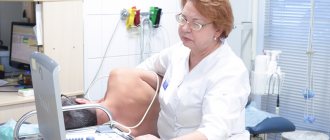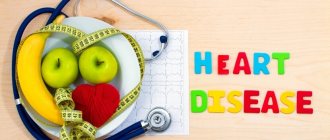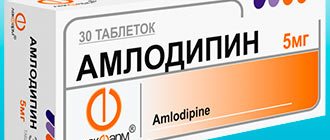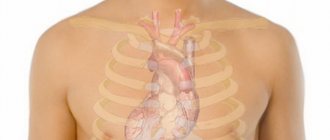For the visually impaired
It is important to know! First emergency aid for cardiovascular diseases
T.N. Bolgova, a therapist at the Department of Prevention and Medical Examinations, recalls the risk factors for cardiovascular diseases, as well as the first urgent actions in emergency situations.
In our country, up to 80% of deaths occur outside of medical institutions - at home, at work, in the country, in public places, most of them occur suddenly.
Statistics show that many patients (or their relatives) call emergency medical care late, which reduces the likelihood of rescue.
By mastering the necessary first aid skills in the form of self- or mutual aid, in most cases you can save the patient’s life.
First aid for a heart attack
Characteristic signs of a heart attack (myocardial infarction):
• sudden (paroxysmal) pressing, squeezing, burning, aching pain in the chest (behind the sternum), lasting more than 5 minutes;
• similar pains are often observed in the left shoulder, left shoulder blade, left half of the neck and lower jaw, both shoulders, both arms, the lower part of the sternum along with the upper abdomen;
• lack of air, shortness of breath, severe weakness, cold sweat, nausea - often occur together or follow/precede discomfort/pain in the chest;
• often these manifestations of the disease develop against the background of physical or psycho-emotional stress, but more often with some interval after them.
Uncharacteristic signs that are often confused with a heart attack:
• stabbing, cutting, pulsating, drilling, constant aching pain for many hours and pain in the heart area that does not change in intensity.
Advice for a patient having a heart attack
If you or someone else suddenly has the above mentioned signs of a heart attack that last more than 5 minutes, don’t hesitate, call an ambulance immediately!
If you have symptoms of a heart attack and there is no way to call an ambulance, then ask someone to take you to the hospital - this is the only right decision. Never drive yourself!
If a heart attack occurs, you must follow the instructions received from your attending physician (if there are none) or act according to the following algorithm:
1. Sit in a chair with an armrest or lie in bed with the head of the bed raised.
2. Take 0.25 g of acetylsalicylic acid (chew the tablet, swallow).
3. Nitroglycerin – spray one inhalation dose into the mouth.
4. Free your neck, ensure the flow of fresh air (open the vents, windows).
If the pain persists, it is imperative to call an ambulance and take nitroglycerin a second time.
Attention! A patient with a heart attack is strictly prohibited from standing up, walking, smoking or eating until specifically authorized by a doctor. You should not take aspirin (acetylsalicylic acid) if you are intolerant to it (allergic reactions), as well as during an exacerbation of gastric and duodenal ulcers.
It is forbidden! Take nitroglycerin for severe weakness, sweating, as well as for severe headache, dizziness, acute impairment of vision, speech and coordination of movements.
First aid for acute cerebrovascular accident
The main signs of stroke:
• numbness, weakness, immobilization of arms, legs, half of the body, distortion of the face;
• speech impairment (slurred, unclear speech, complete loss of speech);
• disturbances or loss of vision, double vision;
• imbalance and coordination of movements;
• unusual severe headache;
• confusion or loss of consciousness, uncontrolled acts of urination and defecation;
If any of these signs suddenly appear, immediately call an emergency medical team, even if these manifestations of the disease were observed for only a few minutes.
Algorithm of emergency actions in case of stroke - a reminder to the patient
1. Urgently call an ambulance team.
2. Before the arrival of the emergency medical team:
• If the patient is unconscious, place him on his side, remove removable dentures, food debris, vomit from the mouth, make sure that the patient is breathing.
• If conscious, help him take a comfortable sitting or semi-sitting position in a chair or on a bed, placing pillows under his back.
• Provide fresh air. Unbutton your shirt collar, belt, waistband, and remove tight clothing.
• Measure blood pressure if its upper level exceeds 220 mmHg. Give the patient the blood pressure-lowering drug he was taking previously.
• Measure your body temperature. If a person’s body temperature is 38°C or more, give the patient paracetamol 0.5 mg, chew, swallow (if paracetamol is not available, do not give other antipyretic drugs).
• Place ice in waterproof bags on your forehead and head and wrap it in a towel.
• If the patient has difficulty swallowing and saliva is dripping from his mouth, tilt his head towards the weaker side of the body and blot the dripping saliva with a clean napkin.
• If the victim is unable to speak or has slurred speech, reassure and reassure him that the condition is temporary. Hold his hand on the non-paralyzed side, stop him from trying to talk, and don't ask questions that require an answer. Remember that although the patient cannot speak, he is aware of what is happening and hears everything that is said around him.
First aid for hypertensive crisis
Hypertensive crisis is a condition manifested by high blood pressure (BP) (systolic - “upper” blood pressure is usually more than 180 mm Hg, diastolic - “lower” - more than 100 mm Hg) and the following main symptoms:
• headache, often in the occipital region, or heaviness and noise in the head;
• flashing “flies”, a veil or a net before the eyes;
• nausea, feeling of exhaustion, overwork, internal tension;
• shortness of breath, weakness, constant monotonous aching pain/discomfort in the heart area, sometimes the appearance or increase of pastosity (swelling of the skin of the face, arms, legs).
Algorithm of emergency actions during a hypertensive crisis - a reminder for the patient
If symptoms of a hypertensive crisis appear, you must:
• Remove bright light, ensure peace, access to fresh air (unbutton your shirt collar, ventilate the room, etc.).
• Measure blood pressure, and if its “upper” level is greater than or equal to 160 mm Hg. You must take an antihypertensive drug previously recommended by your doctor. In the absence of an antihypertensive drug recommended by a doctor or when a blood pressure level is registered above 200 mm Hg. , it is necessary to urgently call an ambulance.
• Before emergency medical services arrive, you should, if possible, sit in a chair with armrests and take a hot foot bath (put your feet in a container of hot water).
Attention! A patient with a hypertensive crisis is prohibited from any sudden movements (suddenly standing up, sitting down, lying down, bending down), pushing hard and any physical activity.
• 40-60 minutes after taking the medicine recommended by the doctor, it is necessary to re-measure blood pressure and if its level has not decreased by 20-30 mm Hg. from the initial state and/or the condition has not improved - urgently call an ambulance.
• If you feel better and your blood pressure decreases, you need to rest (lie in bed with the head of the bed raised) and then contact your local (family) doctor.
When talking with your doctor, you need to clarify what medications you need to take if a hypertensive crisis develops, clearly write down their names, dosage and time sequence of taking them, and also check with your doctor for what manifestations of the disease you need to urgently call an ambulance.
All patients with hypertension need to create an individual mini-first aid kit for a hypertensive crisis and carry it with them at all times, since a hypertensive crisis can develop at any time and anywhere.
RISK FACTORS
Chronic non-infectious diseases, which are the main cause of disability and premature mortality of the population of the Russian Federation, include diseases of the circulatory system (coronary heart disease, cerebrovascular diseases), malignant neoplasms, diabetes mellitus, chronic lung diseases, glaucoma. These diseases cause 75% of all disability and mortality in our country. It is very important that all these diseases have a common structure of risk factors for their development, and most of them can be corrected. At the same time, the experience of a large number of countries around the world has shown that interventions over 10 years aimed at reducing the prevalence of risk factors reduce mortality from chronic non-communicable diseases by an average of 59%.
Criteria for CND risk factors:
• Elevated blood pressure – SBP – equal to or higher than 140 mm Hg, DBP equal to or higher than 90 mm Hg, or antihypertensive therapy.
• Dyslipidemia - deviation from the norm of one or more indicators of lipid metabolism (total cholesterol 5 mmol/l or more, triglycerides - more than 1.7 mmol/l HDL cholesterol in men less than 1 mmol/l, in women less than 1.2 mmol/l , LDL cholesterol more than 3 mmol/l.)
• Hyperglycemia – fasting plasma glucose level of 6.1 mmol/l or more, or the presence of diabetes mellitus.
• Tobacco smoking – smoking at least one cigarette or more every day.
• Poor nutrition – excessive consumption of food, fats, carbohydrates, consumption of table salt more than 5 grams. per day, insufficient consumption of vegetables and fruits.
• Excess body weight – body mass index 25 – 29.9 kg/m² or more.
• Obesity – body mass index 30 kg/m² or more.
• Low physical activity - walking at a moderate or brisk pace for less than 30 minutes per day.
• The risk of harmful use of alcohol and the risk of consuming narcotic drugs and psychotropic substances without a doctor’s prescription.
• Family history of:
- cardiovascular diseases (presence of myocardial infarction and/or cerebral stroke in close relatives)
- for malignant neoplasms
— for chronic diseases, lower respiratory tract
- diabetes mellitus in close relatives.
Therapist at the Department of Prevention and Medical Examinations T.N. Bolgova
Back
Signs of a heart attack
A heart attack does not always mean a sharp stabbing pain in the chest. In some patients it may start in a different form. If even minor symptoms of a pre-infarction condition appear, you should see a specialist or call a cardiologist at home. The sooner the problem is detected, the easier the treatment is for the patient and the doctor will be able to solve it without consequences for health.
The following conditions may be warning signs of an attack:
Discomfort in the chest, manifested in a feeling of squeezing, pressing pain. Lasts several minutes, releases and appears again;
Shortness of breath, heaviness and discomfort in the chest when inhaling.
Additional symptoms to watch out for:
- Pale skin;
- The appearance of cold sweat;
- Increased or slow heartbeat;
- Nausea, vomiting, upset stomach;
- Anxiety and fear.
If you identify these symptoms in yourself or your loved ones, you should immediately call a doctor. In the event of a sudden heart attack, there is no time to wait for a doctor and you need to provide help yourself.
Preventing a Heart Attack
People with high blood pressure, diabetes mellitus, obesity and ischemia are at increased risk. Attacks are also provoked by unfavorable environmental conditions, alcohol abuse and smoking.
Regular examination by a cardiologist in Rostov-on-Don and monitoring of heart function can help reduce the likelihood of a heart attack. The medical office employs an experienced cardiologist who will conduct an appointment or come to your home for an examination. On the medical center’s website you can make an appointment or check the doctors’ schedule.
What to do if you have a heart attack?
Before doctors arrive, it is necessary to provide first aid to the victim:
- Try to calm down and calm down yourself;
- Lay down or make a person sit down;
- Give aspirin and nitroglycerin to improve blood circulation;
- If breathing stops, begin cardiopulmonary resuscitation.
If you have your first heart attack, you may need to help yourself until medical attention arrives. In this case, the main thing is to try to calm down and seek help. An active cough will help: take a deep breath and cough deeply. This will supply oxygen to the lungs and restore cardiac activity until doctors arrive.







